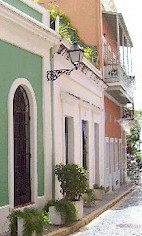|
 |
With
a population of nearly 4 million, Puerto Rico
may be an economic territory of the United States, but its people are fiercely independent.
Rarely will you find an American flag
flying
high,
without a corresponding Puerto Rican flag
nearby, sometimes flying even higher.
We call this IDENTITY … and we love it!! |
|
Old
San Juan
To
protect the transportation of gold, silver and
jewels,
on its route from America to Spain, the Spaniards
built
a series of forts in the Caribbean. The beautiful city of San
Juan was founded in 1521. A massive wall and forts were built
around the city to protect it from the enemy.
The city was
used as a
stopover
for ships that came from Spain and a
stronghold to prevent
the enemy from taking control of the island and making Puerto Rico
an enemy base. These walls and fortifications are part of the
heritage left by Spain
to Puerto Rico. Today the
cobblestone
streets,
interior patios, hanging balconies, plazas, and chapels make of
this historic city a
charming and
picturesque place to visit.
Military
Adventures of San Juan
In
1595, Sir Francis Drake attacked San Juan
in pursuit of gold and
silver
stored in "La
Fortaleza". The artillery in "El Morro" effectively defended the
city and
punished the invaders
sending them away with many
casualties. In 1598,
Sir George Clifford, Count of Cumberland, landed in San Juan and
sieged the city but
could not take El Morro.
After suffering exhaustion and sickness they were forced to leave.
Even the Dutch, Commanded by General Boudewin Hendricksz, landed
on San Juan in 1625, the Spanish resistance at El Morro made it
impossible for them
to
take over. The Dutch
burned down the city,
including La Fortaleza, and left.
Some
Cool Places to Visit
A
leisurely walk through
Old San Juan is one of the most pleasant experiences anyone could
have in Puerto Rico. The colonial architecture of hanging
balconies and cobblestone streets make you feel like you have
gone back
in time.
Here are only some of the nice places to visit in Old San Juan.
•
Paseo
de la Princesa.
A
great place to spend weekend afternoons where local artisans
display and sell their work. Also there is live music early Sunday
evenings and on many other occasions.
•
Massive
City Wall.
Construction
of this 42-foot-high wall that surrounded the city began in the
1630s. It is made of solid sandstone blocks and held together with
mortar,
limestone, sand and
water.
• Puerta
de San Juan.
The
San Juan Gate was constructed in 1520. This strong, heavy wooden
door was the official entrance for those who came to Puerto Rico
on
wooden sailing ships
during the colonization.
•
Catedral
de San Juan.
This beautiful Cathedral, built in 1540 is a good
example of Gothic architecture in the New World. Here in a
marble tomb
lie the
remains of Juan Ponce
de Leon.
|
|
flying:
moving in the wind (flameando)
nearby:
very close, not far away (muy cerca)
jewels:
precious or semiprecious stones (joyas)
built: constructed (construyeron)
stopover: stopping place on a journey (escala, en un
viaje)
stronghold: a fortified place (fortificación)
heritage: inheritance (herencia)
cobblestone streets: streets paved with rectangular stones (calles
empedradas)
charming: interesting, fascinating (encantador)
in pursuit of: in search of (en busca de)
stored: kept
(conservados, almacenados)
punished: penalized (castigaron)
casualties: soldiers injured, killed or captured
in a military engagement (bajas) |
sieged: blocked by armed forces (sitió)
take over: take control (toma de poder)
burned down: destroyed by fire (incendiaron)
leisurely: not hurried or forced (sin apuro,
tranquila)
gone back in time: returned to old times (regresado
al pasado)
construction: building (la construcción)
mortar: a bond for covering a wall (mezcla de
cemento)
limestone: a sedimentary rock (piedra caliza)
wooden: made of wood (de madera)
marble tomb: a grave in crystalline stone (tumba de mármol)
lie: rest in a horizontal position (yacen)
remains: dead body (restos). |
|